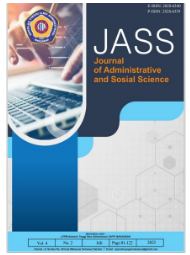Peran Efikasi Diri, Pelatihan Karyawan, dan Pengembangan SDM dalam Meningkatkan Kinerja Karyawan
DOI:
https://doi.org/10.55606/jass.v6i2.1862Keywords:
Employee Performance, HR Development, Job Training, Self-EfficacyAbstract
The role of job training, self-efficacy, and human resource development (HRD) in improving employee performance is discussed in this study. The problem raised is how these three components can synergistically influence employee work efficiency, considering the many challenges faced by organizations in optimizing their human resource potential. The library method and literature review approach are used in this study. This involves the analysis of primary and secondary data from reliable international journals indexed by Scopus and national journals indexed by Shinta. These data were collected through a review of relevant literature covering theories and empirical research on self-efficacy, job training, HRD, and their effects on performance. The results of the study indicate that increasing employee motivation and confidence to complete assigned tasks is very important. Technical skills and adaptability to changes in the work environment are improved through competency-based job training. Meanwhile, an innovative and productive work culture is generated through continuous learning and mentoring programs. When used together, these three components can contribute to improving individual and organizational performance. According to this study, to maintain the sustainability and competitiveness of organizations in the modern era, a holistic approach to HR management is essential
References
Aguinis, H., & Kraiger, K. (2019). Benefits of training and development for individuals and teams, organizations, and society. Annual Review of Psychology, 60(1), 451–474. https://doi.org/10.1146/annurev-psych-122216-011605
Albrecht, S. L., Bakker, A. B., Gruman, J. A., Macey, W. H., & Saks, A. M. (2018). Employee engagement, human resource management practices, and competitive advantage: An integrated approach. Journal of Organizational Effectiveness: People and Performance, 5(2), 142–161. https://doi.org/10.1108/JOEPP-04-2018-0023
Alfes, K., Shantz, A., Truss, C., & Soane, E. C. (2013). The link between perceived HRM practices, engagement, and employee performance. Human Resource Management Journal, 23(4), 433–449. https://doi.org/10.1111/1748-8583.12015
Baldwin, T. T., & Ford, J. K. (1988). Transfer of training: A review and directions for future research. Personnel Psychology, 41(1), 63–105. https://doi.org/10.1111/j.1744-6570.1988.tb00632.x
Baldwin, T., & Ford, J. K. (2022). The six factors influencing training transfer in workplace settings. The International Journal of Management Education, 20, 100649. https://doi.org/10.1016/j.ijme.2022.100649
Bandura, A. (2012). On the functional properties of perceived self-efficacy revisited. Journal of Management, 38(1), 9–44. https://doi.org/10.1177/0149206311410606
Boere, N. A., de Jong, B., Jansen in de Wal, J., & Cornelissen, F. (2023). Does training content matter? Differences between soft- and hard-skill trainings in transfer motivation. Journal of Workplace Learning, 35(9), 274–290.
De Jong, B., Jansen in de Wal, J., Cornelissen, F., van der Lans, R., & Peetsma, T. (2023). How to predict transfer of training? Investigating the application of the unified model of task-specific motivation. International Journal of Training and Development, 27(2), 242–262. https://doi.org/10.1111/ijtd.12297
DeNisi, A. S., & Smith, C. E. (2014). Performance appraisal, performance management, and firm-level performance: A review, a proposed model, and new directions for future research. Academy of Management Annals, 8(1), 127–179. https://doi.org/10.5465/19416520.2014.873178
Garavan, T. N., McCarthy, A., & Morley, M. (2021). Global human resource development: Regional and country perspectives. Routledge. https://doi.org/10.4324/9780429455356
Ghosh, P., Chauhan, R., & Rai, A. (2015). Supervisor support in transfer of training: Looking back at past research. Industrial and Commercial Training, 47(4), 201–207. https://doi.org/10.1108/ICT-11-2014-0071
Hartini, H. (2023). Penilaian Kinerja. ResearchGate. https://www.researchgate.net/publication/373688716_PENILAIAN_KINERJA
Huselid, M. A. (2015). The impact of human resource management practices on turnover, productivity, and corporate financial performance. Academy of Management Journal, 38(3), 635–672. https://doi.org/10.5465/256741
Jiang, K., Lepak, D. P., Hu, J., & Baer, J. C. (2012). How does human resource management influence organizational outcomes? A meta-analytic investigation of mediating mechanisms. Academy of Management Journal, 55(6), 1264–1294. https://doi.org/10.5465/amj.2011.0088
Judge, T. A., & Bono, J. E. (2018). Relationship of core self-evaluations traits to job satisfaction and performance. Journal of Applied Psychology, 85(2), 237–252. https://doi.org/10.1037/0021-9010.85.2.237
Kim, S., Tam, L., & Lee, J. (2020). The impact of training programs on employee performance in the global context. Journal of Business Research, 95, 123–136. https://doi.org/10.1016/j.jbusres.2018.10.041
Mdhlalose, D. (2022). Transfer of Training: The Revised Review and Analysis. Open Journal of Business and Management, 10(6), 3245–3265. https://doi.org/10.4236/ojbm.2022.106161
Mdhlalose, D. (2024). Transfer of training on employee job performance: A literature review. International Journal of Academic Research in Business and Social Sciences, 14(2), 1780–1794. https://doi.org/10.6007/IJARBSS/v14-i2/20763
Noe, R. A., Clarke, A. D. M., & Klein, H. J. (2020). Learning in the Twenty-First Century Workplace. Annual Review of Organizational Psychology and Organizational Behavior, 7(1), 245–269. https://doi.org/10.1146/annurev-orgpsych-012119-045238
Razak, S. R. A., & Zahidi, M. H. (2024). Transfer of training on employee job performance: A literature review. International Journal of Academic Research in Business and Social Sciences, 14(2), 1780–1794. https://doi.org/10.6007/IJARBSS/v14-i2/20763
Sahoo, M., & Mishra, S. (2017). Training evaluation and motivation to transfer training: A review of literature. Parikalpana: KIIT Journal of Management, 13(2), 17–28. https://doi.org/10.23862/kiit-parikalpana/2017/v13/i2/164517
Saks, A. M., & Burke, L. A. (2020). Training transfer and transfer climate. Human Resource Management Review, 30(1), 100678. https://doi.org/10.1016/j.hrmr.2019.100678
Sonnentag, S., & Frese, M. (2018). Performance concepts and performance theory. Psychological Management of Individual Performance, 1(2), 3–25. https://doi.org/10.1002/9780470745267.ch1
Tonhäuser, C., & Büker, L. (2016). Determinants of Transfer of Training: A Comprehensive Literature Review. International Journal for Research in Vocational Education and Training (IJRVET), 3(2), 127–165. https://doi.org/10.13152/IJRVET.3.2.4
Torraco, R. J. (2016). Writing integrative literature reviews: Guidelines and examples. Human Resource Development Review, 15(4), 404–428. https://doi.org/10.1177/1534484316671606
Downloads
Published
How to Cite
Issue
Section
License
Copyright (c) 2025 JOURNAL OF ADMINISTRATIVE AND SOCIAL SCIENCE

This work is licensed under a Creative Commons Attribution-ShareAlike 4.0 International License.








